
INTRODUCTION TO PASADENA
Well, I can now admit (now that I’m finally done with it) that I honestly waited and prayed that another neighborhood or community would pass Pasadena in the polls. At the time of writing, Bunker Hill (in Downtown Los Angeles), El Monte (in the San Gabriel Valley), Lincoln Heights (in The Eastside), and Mt. Washington (in Northeast Los Angeles) are all tied for second place. All of those places seem comparatively way more manageable. Pasadena, I worried, is just too big to summarize in a single blog entry. True, I’ve tackled the larger (population-wise) Glendale as well as Long Beach (the second-largest city in Los Angeles County — after Los Angeles, of course). But even at ninth-largest in population (also exceeded by the populations of Santa Clarita in Northwest Los Angeles, Lancaster and Palmdale in the Antelope Valley, Pomona in the Pomona Valley, and Torrance in the South Bay) but Pasadena is big in other ways — almost too stuffed with culture and history to address in this format. Alas, however, the people have spoken, so this entry is indeed about Pasadena. Now that I’m finally done, I hope it is somewhat adequate.
For this entry, I was accompanied by veteran traveling companion Diana Roark, who’s been coming along on these exploratory missions since Season 4‘s episode 16, “Silver Lake – There goes the gayborhood” and Genevieve Liang, making her first appearance after an aborted mission to Compton in which the CARDIS broke down its penultimate time – before its complete annihilation.
PASADENA’S NEIGHBORS AND LOCATION
As I mentioned, Pasadena is only the ninth-largest city in the county. It’s bordered by Highland Park, Eagle Rock, East Pasadena, South Pasadena, San Marino, Temple City, San Gabriel, Arcadia, Sierra Madre, La Cañada Flintridge, and Altadena. Although modern-day Pasadena is mostly located in the San Gabriel Valley, it was first settled near the foothills of the San Rafael range, a mountain range separated from the larger Verdugo Mountain range by the Verdugo Wash. Most of Pasadena is situated on a broad alluvial slope at the mouth of the Crescenta Valley, partially separated from the rest of the San Gabriel Valley proper by the Kinneloa Mesa at the base of the San Gabriel Mountains in the east and the rolling hills of San Marino and South Pasadena to the south. Although with each annexation of the defenseless, unincorporated community of East Pasadena, the city Pasadena spreads deeper into the San Gabriel Valley.

THE CHARACTER OF PASADENA
The first time I visited Pasadena was in 1999 after I drove with my friend Seth (a Chino native) from Iowa to the Southland. We went to Poobah, a beloved local record store established in Pasadena in 1971. As someone new to California, my knowledge of Pasadena was pretty much limited to the Rose Parade and the Jan & Dean song “Little Old Lady From Pasadena,” and I asked Seth if we could walk to the beach from where we were, not realizing that the Pacific was about 46 kilometers west. While we were in Poo-Bah, a commercial was being filmed explaining that some Pacific Gas and Electric Company customers would now be making out their checks to Southern California Edison. Poo-Bah had presumably been chosen in a bid to seem hip and edgy. Reinforcing this notion, the two characters explaining the change were introduced as “Duane” and “Mirth,” a thinly-veiled reference to the recurring Saturday Night Live stars of Wayne’s World, introduced a mere twelve years earlier. This immediately made me feel less intimidated by Southern California Cool or the threat of culture shock.
EATING IN PASADENA
Diana, Genevieve, and I arrived in Pasadena on a crisp, clear, autumn day. We started off with a fine meal at Marston’s, a well-known local eatery established in a Craftsman home back in 1987.
When I first moved to Los Angeles and worked in Old Town Pasadena, one of the first places I ate regularly was A’Float Sushi, on account of their great selection of vegetarian sushi options. There’s meat too, for the omnivores and “beady-eyed vegetarians,” but I can’t vouch for its quality. Also, the sushi comes on boats that circle the chefs in a moat, which is always fun.
When I discovered King Taco (#21), a new world was opened to me. King Taco was started in Cypress Park and is now a local chain – my favorite Mexican chain to this day. It was at the King Taco in Pasadena that I first heard Mikel Erentxun‘s Spanish language cover of either The Smiths‘ “Esta luz nunca se apagará” or a solo Morrissey‘s “Todo es igual siempre.” In a weird poetic arc, years later when LATV aired the last episode of Los Ilegales, they played a countdown of the top Rock en Español videos of all time, broadcasting from the East Los Angeles location (#2) of King Taco and proclaiming Morrissey’s English-language original “Everyday is like Sunday” the number one exemplar of the genre.
Other Pasadena joints I’ve enjoyed on several occasions include the wild, Armenian smorgasbord, Burger Continental; the delicious, if decadent, Gourmet Cobbler Factory; the Himalayan Cafe holds many culinary and personal memories, as does New Dehli Palace Cuisine of India. And finally, I have to give love to Orean the Health Express, the country’s first and oldest Vegetarian fast-food take-out joint, which appeals more to vegetarians motivated by ethics and environmentalism rather than health… like me!
Other eateries include Alberto’s Mexican Food, AKA – American Bistro, All India Cafe, Amigo’s Restaurant, Andrea’s Petting Zoo and Bakery, Arroyo Chop House, Arturo’s Taco Truck, Aux Delices, Avanti Cafe, Azeen’s Afghani Restaurant, B-Man’s Teriyaki & Burgers, Bar Celona, BC’s Donuts, Barney’s Limited, Beany’s Cafe, Beckham Grill Restaurant, Beyond the Olive, Big City Hot Dogs, Big Mama’s & Papa’s Pizzeria, Bistro 45, Bobby’s Place, Bonnie B’s Smokin, Brothers Pies N’ Fries, Bua Na Thai Cuisine, Burrito Express, CHAM Korean Bistro, Cafe Cordova, Café Linda’s, Café Santorini, Cafe Verde, Carmela Ice Cream, Celestino, Cherry on Top, Cheval Blanc, Chinese Cafe, Chinese Gourmet Breakfast, Corner Bakery Cafe, Crepe Studio, Culture 22, Cypress Best Burgers, D’odici Desserts, Daisy Mint, Dena Burgers, Dia de los Tacos, Dog Haus, Domenico’s Italian Restaurant, Dream Dinners Pasadena, 1810 Argentinean Restaurant, Einstein Bros Bagel, El Chavo Taco Stop, El Metate, El Pollo Unico, El Portal Restaurant, El Taquito Mexicano Truck, El Toreo, Elements Kitchen, Ernie’s Al Fresco, Euro Pane Bakery, Father Nature’s Lavash Wraps, 54 Holly, Fortune Chinese Cuisine, Garni Meat Market, Gerlach’s Grill, Gladstone Donut House, Go Go Sushi, Grand Chicken, Grandview Palace No 2, Green Earth Vegan Cuisine, Green Street Restaurant, Green Street Taqueria, Gyu-Kaku, Haiku Kitchen, Heidar Baba, Hey That’s Amore, Honeybaked Ham Co, House of Basturma, Houston’s, Hungtington Memorial Hospital Cafeteria, Huntington Catering Company, Ichima, In-N-Out Burger, Indochine, Istanbul Catering, Jake’s of Pasadena, Japon Bistro, KindKreme, King’s Row Gastropub, Kingston Cafe, La Caravana Restaurante Salvadoreno, La Estrella, La Grande Orange Cafe, La Luce Cafe & Deli, Le Pain Quotidien, Lee’s Hoagie House, Lemonade, ‘Lette Macarons, Little Britain, Los Primos, Louisiana Fried Chicken & Donuts, Lovebirds Cafe & Bakery, Luciano’s Ristorante, Lucky Boy Drive-In, Ma Jasmin’s, Maison Akira, Mako Bowl, Malbec, Maria’s Italian Kitchen, Matsuri, Mediterranean Cafe, Mezbaan Indian Cuisine, Mi Casa Mexican Food, Mignon Chocolate, Mijares Mexican Restaurant, Mr. Goods Donuts Shop, My Vegan, New York Deli, Nine & Nine Thai Kitchen, Noda Sushi,n2 Catering, Numero Uno Pizza Pasta & More, O2 Sushi, Oba Sushi Izakaya, Panda Inn Restaurant, Panos Bakery, PappaRich, Parkway Grill, Pasadena Fish Market, Pasadena Sandwich Company, Picante, Piccomolo Italian Ice Cream, Pita Jungle, Polkatots Cupcakes, Pollos Puebla #1, POP Champagne and Dessert Bar, Porta Via Italian Foods, Porto Alegre Churrascaria, Poster’s Donuts, Pronto Donuts, Puebla Tacos No 3, Pulley’s, Quadrupel Brasserie, Qzilla BBQ, Rasta Taco, Roma Italian Deli and Grocery, Root Beer Joe’s Sandwich Shop, Rosarito Mexican Food, Rotisserie Chicken of California, Roy’s Restaurant, Royal Donuts, Rubio’s Fresh Mexican Grill, Russell’s, Ruth’s Chris Steak House, Sachi Sushi Restaurant, Sahara Middle Eastern Cuisine, Saigon Noodle Restaurant, Saladish, Sandwiches by Connal’s, Sandwich Story, Sausalito Mexican Restaurant, See’s Candies, Settebello Pizzeria Napoletano, Sharky’s Wood Fired Mexican Grill, Shogun Restaurant, Smitty’s Grill, Soumarelo, Stonefire Grill, Sugar Fix, Super Burger, Suriya Thai Restaurant, Sushi Ichi, Sushi Kimagure, Sweet Art Cupcake, Tacos El Gallito, Tacos La Doña, Takes the Cake, Tastees Donut & Burger, Technique Restaurant, Tender Greens, Tenno Sushi and Seafood Grill, The Athenaeum, The Burger Shack, The Cheese Store of Pasadena, The Counter, The Habit Burger Grill, The Hat, The Kitchen For Exploring Foods, The Luggage Room Pizzeria, The Market on Holly, The Old Sasoon Bakery, The Original Tops, The Raymond Restaurant, The Royce, The Slaw Dogs, The Vol 94, The White Hut, Three Dog Bakery, Tommy’s Original World Famous Hamburgers, Tonny’s Restaurant, Top Restaurant, Tortas 2 Die 4, Tortas Mexico, Tre Venezie Trattoria, 21 Choices, Tutti Gelati, Vero’s Restaurant, Viktor Benes Bakery Pasadena, Vince’s Deli, Violet’s Cakes, Vrej Pastry, Wahoo’s Fish Taco, Wok Master, Wokcano, Wonder Burgers, Yahaira’s Cafe, Yard House, Yujean Kang’s, and Zankou Chicken.
PASADENA’S NEIGHBORHOODS
Pasadena is a city comprised of many neighborhoods: Allendale, Annandale, Arroyo Terrace, Arroyo del Mar, Banbury Oaks, Bellefontaine, Brigden Ranch, Brookside Park, Bungalow Heaven, California Village, Casa Grande, Catalina Villas, Chapman Woods, Civic Center, Daisy Villa, Devil’s Gate, East Washington Village, Eaton Canyon, Garfield Heights, Governor Markham, Hastings Ranch, Historic Highlands, Jefferson Park, La Pintoresca, Lamanda Park, Lexington Heights, Lincoln-Villa, Linda Vista, Lower Arroyo, Madison Heights, Marceline, Monk Hill, Muir Heights, Normandie Heights, Oak Knoll, Old Town, Olive Heights, Orange Heights, Playhouse District, Prospect Park, Raymond Hill, San Rafael Hills, Sierra Madre Villa, South Lake, The Oaks, Victory Park, Villa Parke, and Washington Square. If you’d like to vote for any specific neighborhoods, therefore allowing me to get more in-depth, vote for them by letting me know in the comments. Although Pasadena is sometimes mischaracterized as a sleepy, white suburb, the population of is actually highly diverse — 39% white (plurality English), 33% Latino (mostly Mexican), 14% black, and 10% Asian (plurality Filipino).
A BRIEF HISTORY OF PASADENA
The area that now makes up Pasadena was for over 1,000 years to the Hahamog’na branch of the Tongva. A Tongva fool trail, now known as Gabrielino Trail, ran from the present-day location of the Rosebowl up along the Arroyo Seco, past NASA‘s Jet Propulsion Laboratory into the San Gabriel Mountains. In 1770, the Spanish invaded Tovangar and established the Mission San Gabriel Arcángel in the San Gabriel Valley’s Whittier Narrows (later it was moved to San Gabriel). That year a Spanish expedition led by Gaspar de Portolà passed through the area. This led the way for the Spanish conquest of the aboriginal population. Their leader, Hahamog’na, for whom the tribe was named, changed his name to Pascual upon his conversion to Christianity.
Mexico, including California, declared independence from Spain in 1810. In 1833 the missions were secularized. In 1834, a land grant named Rancho del Rincon de San Pascual (so named because it was deeded on Easter Sunday) was given to Eulalia Perez de Guillén Mariné of Mission San Gabriel Arcángel and her spouse Juan Mariné by the Mexican governor José Figueroa.
EARLY AMERICAN PASADENA
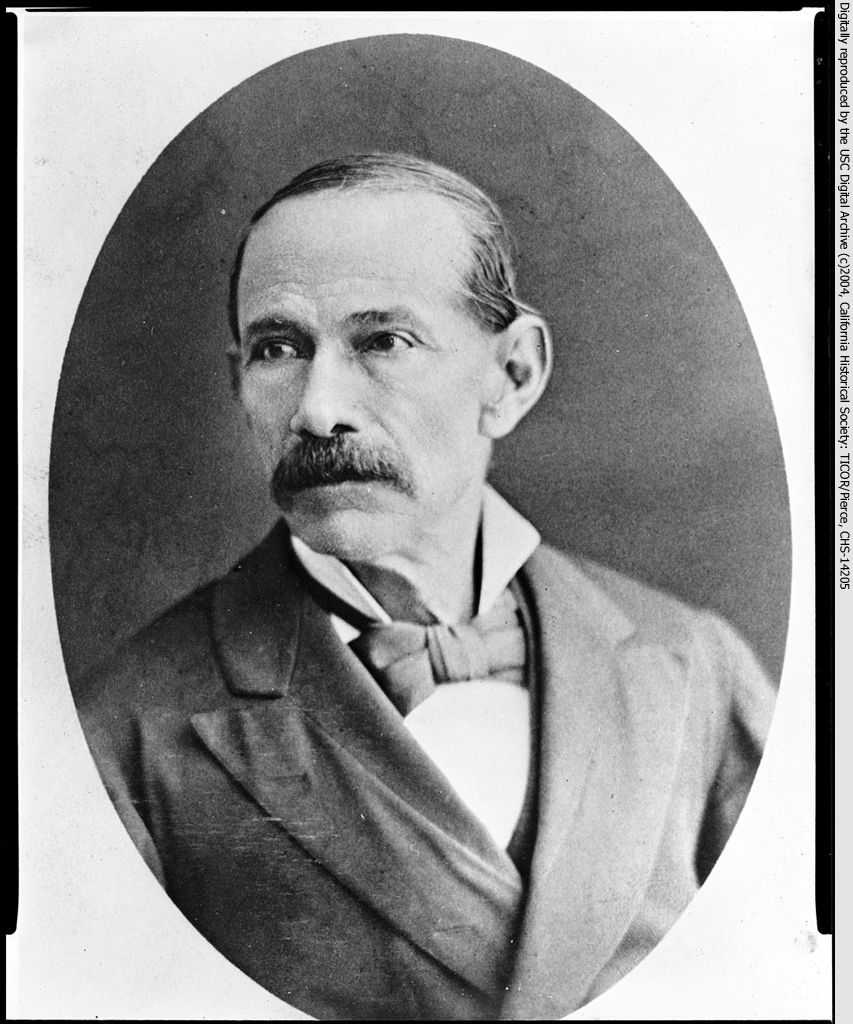

In 1848, California became part of the USA, following the conclusion of the Mexican-American War. In 1850, California was granted statehood. In 1859, the rancho’s last Mexican owner, Manuel Garfias, sold the land to John Griffin and Benjamin “Don Benito” Wilson, who established Lake Vineyard for muscat production. Benjamin Eaton, who worked for Griffin and Wilson, had first brought water from Arroyo Seco and Eaton Canyon in the 1860s to his vineyard, a development that made the growth of Altadena, Pasadena and South Pasadena (aka the Figueroas) possible. The group hoped it would help them develop and sell what they called San Pasqual Plantation, but by 1870, they gave up.
In 1872, a sickly doctor named Thomas Elliot sent an exploratory group west, led by Daniel M. Berry, in search of a warmer climate in which to establish a farm. In what’s now Pasadena they established the Indiana Colony between Fair Oaks Avenue and the Arroyo Seco across from Lake Vineyard. A year later the Indiana Colony — founded by settlers from Indiana, Iowa, and Michigan — of California formed to purchase approximately 4,000 acres from Wilson, Griffin, and Eaton. Mail for the Indiana Colony was addressed “Indiana Colony via Los Angeles,” which was too much of a pain. Potential alternate names bandied about included Buena Vista, Hesperia, Indianola, Muscat, New Granada, and Orange Grove, among others. Finally, “Pasadena” was settled upon, an Ojibwe term that means “of the valley.” In 1875, the residents of the colony included forty houses and a grove of 10,000 newly-planted citrus trees. In 1876, the Southern Pacific Railway arrived in neighboring Los Angeles and a real estate boom followed.
In 1880, the population of Pasadena was only 391. In 1885, the Southern Pacific reached Pasadena and the city was incorporated the following year with a much larger population of 2,700. Although the economy was fueled primarily by wine and brandy grapes (and walnuts and olives); the pressure of the temperance movement resulted in the ban of liquor in February 1887. That year the Sunny Slope Winery was sold and the Altadena subdivision was launched — although Pasadena would continue to annex portions of that city until 1956. To avoid annexation, South Pasadena was incorporated in 1888. To this day, only neighboring East Pasadena remains unincorporated which is why Pasadena grows easterly. For the remainder of the 19th century, Pasadena was primarily a draw for vacationing Easterners and Middle Westerners — especially consumptives and asthmatics. To serve them, the Los Angeles House Hotel opened in 1883. The first proper resort hotel in the area was the Raymond Hotel, which opened in 1886 atop Bacon Hill (later renamed Raymond Hill) in South Pasadena.
TOURNAMENT OF ROSES
In 1890, the first Tournament of Roses Parade was organized by The Valley Hunt Club, patterned after a European festival of roses and meant to showcase Pasadena’s beauty and climate at a time that much of the US is in the throes of bleakest winter. In 1895, the Pasadena Tournament of Roses Association took over from the original organizers. A handegg game was added in 1902 to help fund the cost of the parade and was originally known as the “Tournament East-West football game.” As a kid, primarily motivated by a predilection for underdogs, I always watched the Cotton Bowl Parade instead.
CALTECH
The California Institute of Technology (commonly referred to as Caltech) was founded in 1891 by Amos G. Throop as Throop University. It acquired its current name in 1920. 31 Caltech alumni and faculty have won the Nobel Prize and 66 have won the National Medal of Science or Technology.
39% of the student body is comprised of Asian-Americans and 35% white. The CBS sitcom Big Bang Theory is set at Caltech. Interestingly (but sadly not surprisingly as whitewashing is one of Hollywood’s chief strengths) only one of the principal actors (Kunal Nayyar) on the show is Asian American and the remaining (88%) are white.
One of Caltech’s most famous graduates is Taiwanese-American astrophysicist Tyson Mao. The speedcuber (as competitive Rubik’s Cube solvers refer to one another) co-founded the World Cube Association and in 2006 set the world record for the 3x3x3… blindfolded. That same year he appeared as a participant on CW‘s Beauty and the Geek. He’s also appeared on Anderson Cooper 360, Good Morning America, Show Us Your Character, The Tonight Show, TWINS, and Taiwan‘s 綜藝大哥大.
For urban spelunkers and fellow explorers, the fact that most buildings on the Caltech campus are connected by a network of steam tunnels, pipes, &c is titillating and the art found in them is testament to their popularity and the spirit of those who explore them. My friend (and Kayo Dot violinist) Mia Matsumiya — who is famously small and thus able to squeeze into spaces that the rest of us can’t — explored the system and detailed her adventure (see here).
CALIFORNIA CYCLEWAY
Pasadena resident Horace Dobbins started work on the Cycle-Way Company. In 1897, permission to build an elevated, fourteen-kilometer, wooden bike trail connecting Pasadena to Downtown Los Angeles was granted. Construction began in 1899. The stations, where bikes could be serviced, were in the Moorish style. The cycleway opened in 1900. It was never completed, however, and the cycleway stretched two kilometers reached from a terminus near Hotel Green to one near the Raymond Hotel.
THE EARLY PASADENA HOTEL SCENE
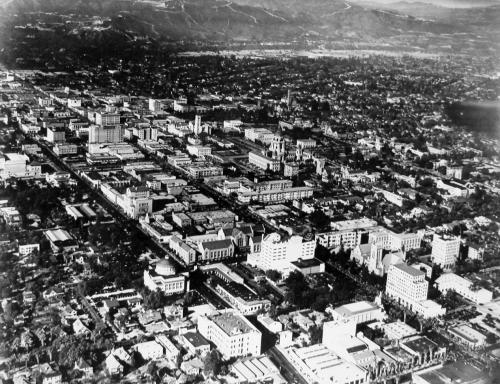
In the early 1900s, numerous Christian houses of worship popped up along Marengo Avenue, which resulted in its being regarded as an Avenue of Churches. Meanwhile, Colorado was quickly established as a hotel district. The Maryland Hotel was destroyed by a fire in 1914 and redesigned by Myron Hunt and then rebuilt. Most of it was demolished in 1934 but the remaining residential tower of the Maryland has been a co-op since 1953. There was also the Constance Hotel, the Marengo Hotel, and the Vista del Arroyo. Today, however, the best known is Castle Green.
CASTLE GREEN
The Frederick Roehrig-designed Green Hotel began construction in 1887 and was completed in 1903, named after George Gill Green. He later added two more buildings to the structure — Castle Green was the second building and was originally known as the Central Annex. In 1924, the Central Annex was subdivided into fifty apartments and renamed Castle Green. In the 1920s, one of the buildings caught fire after a guest fell asleep with a lit cigar in the smoking parlor. It was afterward abandoned instead of repaired and sat empty until 1935 when it was further damaged by the Long Beach Earthquake and subsequently demolished completely. The surviving Castle Green is listed on the National Register of Historic Places and the State Historic Register. It’s been used in numerous films, commercials and TV series, including Buffy the vampire slayer, The last samurai, Deja vu, We were soldiers, Little rascals, The sting, The time machine, Bobby, Murder, she wrote, Dallas, Wild at heart, Sneakers, Bugsy, The man with two brains, Sisters, Puppetmaster, Miracle on 34th Street and more.
THE LANGHAM HUNTINGTON, PASADENA
The Hotel Wentworth was built by American Civil War veteran General Wentworth in 1906. It was designed by Charles Frederick Whittlesey in Spanish Mission Revival style. After its 1911 purchase byHenry E. Huntington in 1911 it reopened in 1914 as The Huntington Hotel. In 1954 it changed to the Huntington Sheraton. When it failed to live up to new earthquake codes, it was closed. In 1988 it was demolished. It was rebuilt, incorporating its two ballrooms, in 1991 – using many of the original features. After a stint as a Ritz-Carlon, in 2007 it became the Langham Huntington, Pasadena.
MILLIONAIRE’S ROW
In 1900, Pasadena‘s population was 9,117. In, 1901 Henry E. Huntington established the Pacific Electric Railway. Orange Grove quickly became the most desirable address for monied toffs and with 52 massive mansions lining it by 1902, it quickly came to be nicknamed “Millionaire’s Row.” Notable residents included Adolphus Busch, Aleister Crowley, David and Mary Gamble, L. Ron Hubbard, and William Wrigley Jr. Behind Orange Grove lies Grand Avenue, another street lined with historic estates that were at various times home to Jared Torrance (founder of the city of Torrance), JB Van Nuys (founder of the city of Van Nuys), the Cox family (of Cox Communications) the Maxwell family (of Maxwell House), the Spauldingfamily (of the sporting goods company) and Howard Huntington, of the Huntington family.
On the day of our visit we stumbled across the Millard House, nicknamed La Minatura. Built in 1923, it was the first of Frank Lloyd Wright‘s four textile block houses, done in the Mayan Revival style.
BUSCH GARDENS
German-born Missourian beer baron Adolphus Busch built the first Busch Gardens in Pasadena in 1905. When he died in 1913, his wife offered the park to Pasadena. The city passed and the gardens later appeared in films including The adventures of Beau Geste, Robin Hood, The Canterville Ghost, Carefree, Citizen Kane, Daddy-Long-Legs, Doctor Dolittle, Dr. Jeckyll and Mr. Hyde, Duck Soup, Frankenstein, Gone with the Wind, It Happened One Night, Jack and the beanstalk, King of the Jungle, Night and Day, The Silver Lining, Son of Fury – The Story of Benjamin Blake, The Son of Tarzan, Stella Maris, Take a Letter, Darling, They Died with Their Boots On, The Three Musketeers, and Watch on the Rhine. It closed in 1937.
GREENE & GREENE
1902-1913 was the major period of work by Greene & Greene, an architectural firm established by Ohioan brothers Charles Sumner Greene and Henry Mather Greene. Their bungalow houses and “ultimate bungalows” are prime examples of Arts and Crafts architecture.
ROBERT R. BLACKER HOUSE
Often referred to as the Blacker House, the Robert R. Blacker House was built in 1907 for Robert Roe Blacker (a retired Michigan lumberman) and his wife, Nellie Canfield. In the 1985 movie Back to the Future, interior shots of Doc Brown‘s house were taken inside the home. Also in 1985, Barton English and Michael Carey purchased the home. In what came to be known as “The Rape of the Blacker House,” English removed and sold many of the original fixtures and replaced them with cheaper replicas. As a result, Pasadena enacted an emergency ordinance in an attempt to limit the ability of Greene and Greene owners to dismantle or otherwise destroy artifacts in their homes. known as the Blacker Ordinance, which attempted to limit the ability of people owning homes designed by Greene and Greene to dismantle or otherwise destroy artifacts therein.
THE PASADENA MOTORCYCLE CLUB
The Pasadena Motorcycle Club was formed in 1907, making it the third-oldest motorcycle club in the US, just behind New York City‘s Yonkers Motorcycle Club (established in 1903) and the San Francisco Motorcycle Club (established in 1904).
GAMBLE HOUSE
The Gamble House was built in 1908 as a winter residence for David B. Gamble of the Procter & Gamble company. It remained in the Gamble family until 1966 when it was deeded to the city of Pasadena in a joint agreement with the USC School of Architecture. Today, two 5th year USC architecture students live in the house — the selected students change yearly. Its exterior served as Doc Brown‘s house in Back to the future.
COLORADO STREET BRIDGE
In 1913, the Colorado Street Bridge was opened, designed and built by THE Kansas City, Missouri firm, J.A.L. Waddell. At first, it was nicknamed the Arroyo Seco Bridge, after the river it spans, but it soon became better known as the Suicide Bridge after numerous people used it to jump to their deaths. It’s been featured in several films including Alias, Seabiscuit, and Sky High.
PASADENA PLAYHOUSE & PASADENA THEATER
Pasadena‘s theater history began in 1888, with the opening of the Williams Hall Parlor Theatre. It was housed in a building that also contained Pasadena’s first post office and first telephone. It has since been demolished. In 1911, the Clune Theater opened, showing vaudeville and film. It later became the Fox Pasadena Theater.
In 1916, actor/director Gilmor Brown took over a burlesque theater for his acting troupe, The Savoy Players. In 1917 he established the Community Playhouse Association of Pasadena, which evolved into the Pasadena Playhouse Association. In 1924, Pasadena’s citizens raised sufficient funds to build a new Spanish Colonial Revival-style theater designed by Elmer Grey. It was completed in 1925. He later began the Midsummer Drama Festivals at the Playhouse and the One-Act Play Tournament. The popularity of theater in Pasadena led none other than Irish playwright George Bernard Shaw to dub Pasadena “the Athens of the West.” In 1969, after the death of Gilmor Brown in Palm Springs, the theater went bankrupt. After being shuttered for 17 years, it re-opened in 1986. In 2010, the theater once again filed for bankruptcy protection and canceled its remaining season. It re-emerged from bankruptcy four months later.
Other significant theaters and theater companies include Jensen’s Raymond Theatre opened in 1921 with a vaudeville performance, the Boston Court Performing Arts Center, the Ice House, the Furious Theatre Company (established 2002), and in 2011, A Noise Within relocated to Pasadena.
THE ROSE BOWL
In 1923, on the site of a former dump, the Myron Hunt-designed Rose Bowl opened, replacing Tournament Park as the location of the Tournament of Roses American Football game. It’s also seen its share of historic music and sports performances. In 1988, Depeche Mode played their final show on the Music for the masses tour to a crowd of 60,453 people. It was filmed and resulted in the DA Pennebaker-directed documentary, 101. In 1996, the US played against Mexico (followed by LA Galaxy vs. Tampa Bay Mutiny) in a football game that attracted 92,216 spectators. In 2009, U2 played the first-ever capacity crowd, 97,014, in the stadium’s history in support of their album, No Line on the Horizon, and as part of their 360° tour. It also hosts a weekly flea market.
PASADENA CIVIC CENTER
In 1927, Pasadena’s Civic Center opened, including a beautiful library and a city hall designed by John Bakewell & Arthur Brown, who incorporated influences of early Renaissance architect, Andrea Palladio.
Behind it, two large bronze portrait sculptures of brothers Jackie and Mack Robinson who, along with their mother, moved to Pasadena in 1920.
NASA JPL
During World War II, Southern California turned into a major staging ground. Factories sprang up, especially in South Los Angeles and the Harbor. Pasadena attracted the higher end of manufacturing and scientific companies, most notably NASA‘s Jet Propulsion Laboratory.
Segregation finally ended in 1948 and by 1950 Pasadena was, along with South Central, Watts, and parts of Midtown, one of the few areas with black majority neighborhoods. (However, the Pasadena Unified School District wasn’t desegregated until 1969!) A steady influx of southern blacks, especially from Louisiana and Texas, made their new homes in Pasadena in the decade that followed.
One was James King Jr., a physical chemist who, after graduating from Morehouse in Atlanta, made his new home in Pasadena. There he spent five years at CalTech where he received an MS. Upon entering the private sector he first worked for Atomics International before attempting to develop a solar-powered car and subsequently working for decades at NASA JPL.
THE PARROTS OF PASADENA
Pasadena and San Marino are home to a large number of naturalized parrots. They’re theorized to have been released during a 1959 fire that destroyed Simpson’s Garden-Town. According to the Parrot Project of Los Angeles, there are as many as five different types of parrots, including the Red-Crowned Amazon Parrot.
THE DOO DAH PARADE
Declining property values attracted artists and bohemians and in 1976, the Doo Dah Parade was launched. The much-loved, zany answer to the classy Rose Parade offered a lighthearted change of pace during Pasadena‘s nadir and has occurred annually every May 1st.
GANGS OF PASADENA
Pasadena began to experience a gang problem in the 1970s. Many Pasadenans moved to areas like the Inland Empire and parts of downtown were left abandoned. Crime soared and developers sought to destroy much of Old Town, catalyzing and invigorating Pasadena’s preservation movement.
In the 1980s, Pasadena’s crime problem continued. During that decade, Elrader “Ray Ray” Browning Jrr an his cocaine and heroin empire from Pasadena. In a twelve year period, prosecutors allege the kingpin ordered the murders of 60 to 70 people. He was arrested in 1987 and in ’88 he was sentenced to two consecutive life sentences.
The vacuum left after Browning’s removal from the streets was filled by more gangs. The most famous episode of gang violence in the era took place in 1993, when three teenagers were murdered by Crips on Halloween. A memorial that reads “In memory of Stephen Coates and Reginald Crawford November 18, 1993 John Muir Student Congress” was placed in honor of the victims.
Pasadena is still marked by the presence of gangs including North Side Pasadena, Pasadena Denver Lanes, Pasadena Latin Kings, South Side Pasadena, and Varrio Pasadena Rifa but crime rate has fallen dramatically since the bad old days and is currently below the national median.
ART IN PASADENA
Pasadena is one of Los Angeles County’s major art centers. In the early 20th century, Pasadena was home to the Arts and Craft Movement‘s Alson S. Clark, Ernest A. Batchelder, Guy Rose and Marion Wachtel. In 1909, the California Art Club was founded (and exists to this day). The Pasadena Society of Artistswas founded in 1925.
The city is also renowned for its Arts Center, the Armory Center for the Arts, the Bunny Museum, art galleries (San Marino Gallery, Williamson Gallery, the Gold Bug, and Zephyr), and large number of public art pieces. Twice a year, Pasadenan cultural institutes participate in the free ArtNight Pasadena. Since its inception, it’s also led to the development of PasadenART Weekend, a three-day event that includes ArtHeritage, ArtMarket, ArtNight, ArtWalk, and ArtPerformance. There’s also the Pasadena Chalk Festival and Museums of the Arroyo Day.
Important public art collections exist at Art Center, Caltech and Pasadena City College. The city of Pasadena also offers public art walking tours.
MUSEUMS OF PASADENA
Pasadena‘s best known museum is the Norton Simon. It was previously known as “The Pasadena Art Institute” and “The Pasadena Art Museum” and was established in 1969 Its collection includes Asian and European paintings and sculpture, as well as tapestries and woodblock prints. Surrounding it in the nicely landscaped grounds are more sculptures. In 1974, art collector Norton Simon absorbed the Pasadena Art Museum’s debts and maintenance and in turn it was renamed in his honor. Simon died in 1993.
Other significant museums in Pasadena include The Pasadena Museum of History (established in 1924), Pacific Asian Museum (founded in 1971), the Kidspace Children’s Museum (established in 1979), and the Pasadena Museum of California Art (founded in 2002).
PASADENA FILM AND TELEVISION
Although the Clune Theater, which opened in 1911, showed films alongside other forms of entertainment, Warner’s Photoplay Theater, which opened in 1914, was the first Pasadena theater dedicated to the exhibition of photoplays… or films as most people refer to them these days.
ACADEMY 6
The Academy 6 was originally a single screen theater known as The Egyptian, (not to be confused with Warner’s Egyptian). By 1942 it was known as The Colorado and was sold to Fox and it became known as The Academy Theater. In the 1980s it was multiplexed and today it shows primarily second-run films at a discount price and boasts a nice selection of flavored popcorn seasonings. The downside? It’s not exactly state-of-the-art and you need to make sure that there isn’t some obstruction blocking your view. Also, it’s pretty grimy so if you’re put off by schmutz and stains, you might want to skip it or arrive after the lights have dimmed.
LAEMMLE’S PLAYHOUSE SEVEN
The Laemmle’s chain is Los Angeles County‘s premiere arthouse chain, with locations in Beverly Hills, Claremont, Encino, Lancaster, Santa Monica, Sawtelle, and West Hills. The company began in 1938 when Max and Kurt Laemmle (cousins of Universal Pictures-founder Carl Laemmle) purchased their first theater in Highland Park. Today it’s owned and operated by Max’s son, Robert Laemmle, and his son, Greg Laemmle. The Pasadena location opened in 2000. It’s also where I first saw Sisu play — against a backdrop of Miyazaki clips.
FILMING LOCATIONS
In addition to the aforementioned films and television series filmed or set in Pasadena, there are over 1,000 more. The majestic Bundy House, built in 1914, served as the Mulray home in Chinatown and the governor’s mansion on television’s Benson. The American Red Cross building served as JAG headquarters on that show of the same name. Arden Villa was featured on The A-Team, Dynasty, and Knightrider. The Walker House was seen on Brothers & sisters. In the film 2012, Pasadena was said to be the residence of Jackson Curtis and it was also, along with Glendale, the setting of Mildred Pierce.
Other films and series filmed in part or in whole in Pasadena include Arrested Development, A Warrior’s Heart, Blow, Bones, Bruce Almighty, CSI, CSI – Miami, Catch Me if You Can, Charmed, Crazy, Stupid, Love, Date NIght, Desperate Housewives, Dexter, Dinner for Schmucks, Enemy of the State, Fast & Furious, Faster, Girl Next Door, Glee, Gone with the Wind, Inception, Iron Man 2, Justified, Kill Bill,K night and Day, Knocked Up, Live Free or Die Hard, Mad Men, Matilda, NCIS, NCIS-Los Angeles, Old School, Parks and Recreation, Pulp Fiction, Scary Movie, Seven Pounds, Spider-Man 3, Stand by Me, The 40-Year-Old Virgin, The Big Lebowski, The Closer, The Green Hornet, The Italian Job, The Lincoln Lawyer, The Muppets, The OC, The Terminator, The X-Files, The Artist, The Mentalist, The Office, The Prestige, The Social Network, Transformers, True Blood, We Bought a Zoo, Wedding Crashers, You Again and way too many titles to mention any more!
PASADENAN ACTORS
Pasadena is also the birthplace of actors like Alison Brie, Christian Serratos, Dana MacDuff, Harry Hamlin, Jaleel White, James Deen, and Sally Field as well as television chef, Julia Child.
PASADENAN TELEVISION
Pasadena Media, created in 2007, is a non-profit organization governed by Pasadena Community Access Corporation (which was established in 1983). The organization currently oversees four television channels: The Arroyo Channel (Channel 32), KPAS (Channel 3), KLRN (Channel 95) and PCC TV (Channel 96) as well as a community media access center. Original programming includes Crown City News, Daheli LIVE, and Good Day Pasadena. From 1988-1998, Pasadena-raised/Chicago-born activist Michael Zinzun hosted and co-produced, with fellow activist and artist Nancy Buchanan, the fondly-remembered program,Message To The Grassroots.
MUSIC OF PASADENA
The Pasadena Symphony formed in 1928. The Los Angeles Music Academy College of Music opened in 1996. Boston Court Performing Arts Center presents concerts throughout the year, known as Music at the Court. Friends of the Levitt has offered free summer concerts in Memorial Park since 2002. TheArcadia-based California Philharmonic (CalPhil) performs two series in Pasadena, Cal Phil at the Ambassador Auditorium and Cal Phil Music Martinis & the Maestro in the Romanesque Room at Castle Green.
Bands and performers from Pasadena include Dan Barrett, Jeff Deyo, Jerry Dixon, Kim Carnes, Poxy Boggards, Primordial Undermind, Red Delicious, Smegma, and most famously, Van Halen. In 2007, Pasadena band Ozma released an album called Pasadena.
MOM & POP RECORD STORES
As far as I know, there are just two independent record stores left in Pasadena. There’s the aforementioned Poo-Bah and Canterbury Records. I guess there’s still a Penny Lane but when I used to work as a manager at that chain, they’d pretty much given up on music and were focused on renting porn and selling postcards. Canterbury also sells a lot of DVDs but I used to go there for the cheap vinyl, usually after shopping at Target or eating Indian nearby.
PASADENA RADIO
In 1967, during the Golden Age of FM Radio, Tom and Raechel Donahue introduced the freeform format demo the basement of Pasadena Presbyterian Church, broadcasting as KPPC at 106.7. Early on air talent included David Lander, Dr. Demento, Harry Shearer and Michael McKean. They established the station as LA’s premier underground station. In 1971 the entire staff was fired and in 1976 the station changed owners and reemerged as KROQ, which before long became one of, if not the, most influential station in the US. After it was purchased by new owners in 1986, it relocated to Burbank and later Los Angeles, where, in 1997, it lost the remainder of its edge when it became part of CBS.
PCC
Broadcasting from Pasadena City College (aka PCC – jokingly nicknamed “Pretty Close to College“), KPCC broadcasts at 89.3. In addition to carrying American public radio programs produced by APM, NPR, PRI, it produces its own programs, including FilmWeek, The Madeleine Brand Show, AirTalk with Larry Mantle,Patt Morrison, Off-Ramp with John Rabe, The Loh Down on Science, and others.
PASADENA PARKS AND RECREATION
Pasadena is a fairly green city with many thousands of trees and numerous parks, including Allendale Park,Arroyo Seco Park, Brenner Park, Brookside Park and Golf Course, Central Park, Eaton Blanche Park,Eaton Canyon Park, Grant Park, Green Park, Hahamongna Watershed Park, Jefferson Recreation Center, La Pintoresca Park, McDonald Park, Pasadena Memorial Park (formerly Library Park),Robinson Park, San Rafael Park, Singer Park, Tournament Park, Victory Park, Villa Parke Community Center, and Vina Vieja Park.
POTABLE PASADENA
For the thirsty, there are a lot of places in Pasadena to get a drink. I once went to the 35er out of curiosity. If millions of TVs blaring various sports in your face with a bunch of dudes is your idea of fun, then definitely check it out. Another time I went undercover as a frat boy to Old Towne Pub as a fascinating social experiment. There’s Lucky Baldwin’s, which appeals to Brit-tards and fans of good beer (but not food), although they seem to always be out of the first four varieties ordered on any given day. Out on the east side of Pasadena, I’ve been to the Colorado Bar numerous times, a pleasant and actual dive bar (and not some theme dive bar). The slightly more upscale Magnolia Lounge, on South Lake, is pretty nice too. On the day of our visit, we watched the sunset and enjoyed a few drinks at the Tap Room in the Langham.
Interestingly, there are seemingly (I don’t feel like counting) more tea houses and coffee bars than bars it seems. Drinking spots include Andy’s Coffee Shop, Bird Pick Tea & Herb, Bliss Cafe and Lounge, Boba World, Bodega Wine Bar, Cafe Alibi, Cafe Culture, Chado Tea Room, Coffee Cantata, Coffee by the Books, Congregation Ale House, Dog Haus Biergarten, Dullahan’s, Eden Garden Bar & Grill, 1886, Gotta Java, Green Street Tavern, Half and Half Tea Express, Intelligentsia Coffee & Tea, Jameson Brown Coffe Roasters, Jones Coffee Roasters, Juice it Up!, Le Petit Vendome, MOKA Cafe, Maui Wowi Hawaiian Coffee and Smoothies, Monopole Wine, Niko and Friends Cafe, Peet’s Coffee & Tea, redwhite+bluezz, Rocket Fizz Soda Pop & Candy Shop, Rose Tree Cottage, Roxolana Restaurant & Wine Bar, Scarlet Tea Room & Fine Dining, Spitfire Saloon, T. Boyles Tavern, Tea Rose Garden, Tea Spots, The Boulevard, The Coffe Bean & Tea Leaf, The Coffee Barrel, The Crepevine Bistro & Wine Bar, The Nose Wine Bar, Tiffany’s Coffee, Vertical Wine Bistro, and Zona Rosa Caffe.
PARTYING PASADENA
Pasadena though a vibrant city, especially during the day, seems pretty sleepy at night. That being said, I’ve never set foot in any of nor attended the following: Club Menage, Esquire Bar & Lounge, Jake’s Diner & Billiard Club, LIV Lounge, Lindy Groove, Lounge 54, The Granada LA, and Third Saturday Swing.
Support Eric Brightwell on Patreon




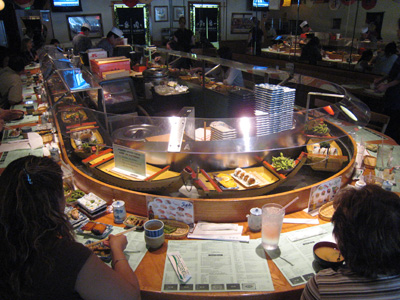
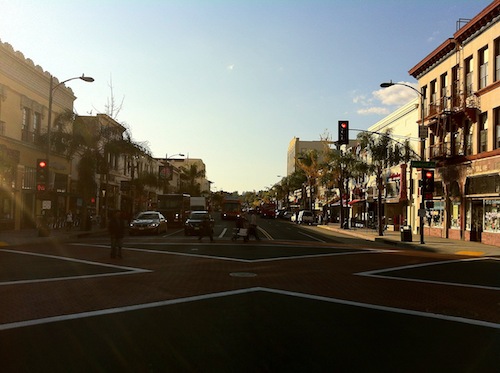



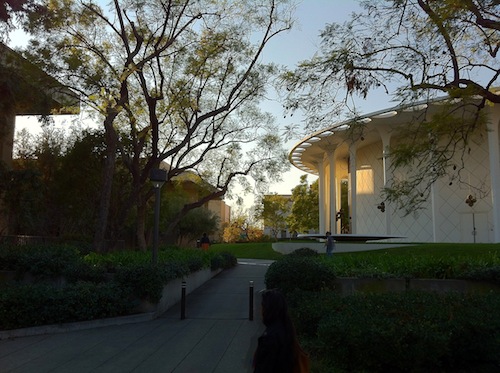
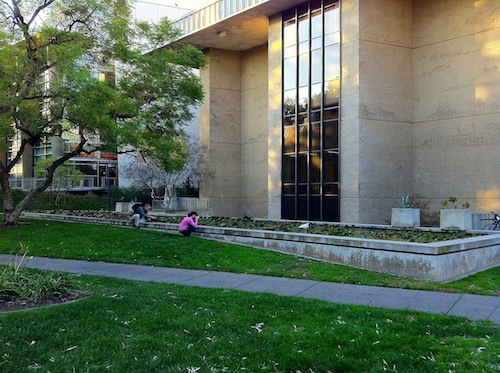

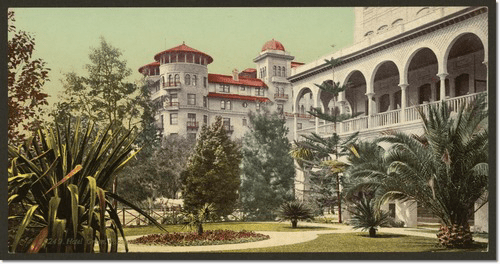
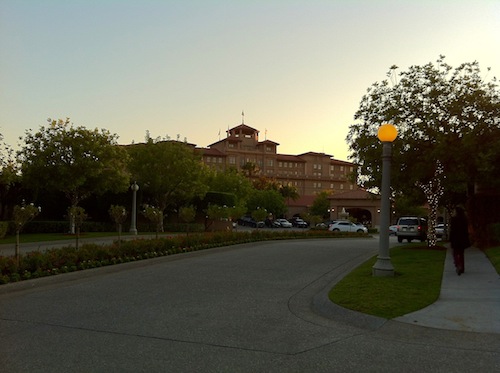

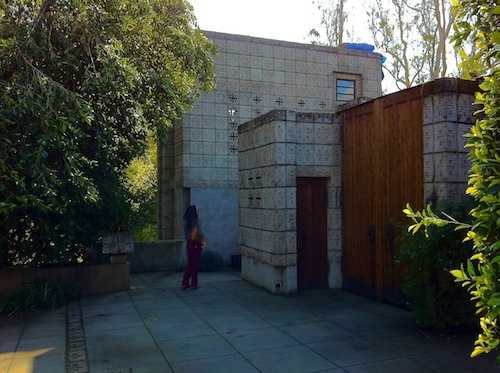
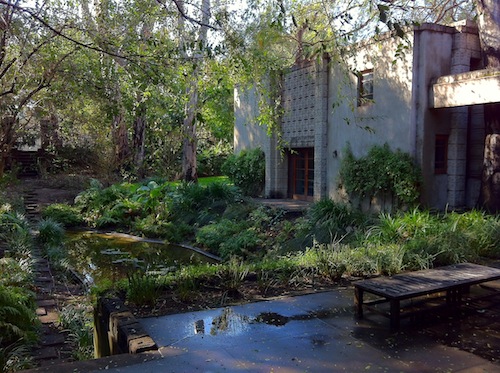
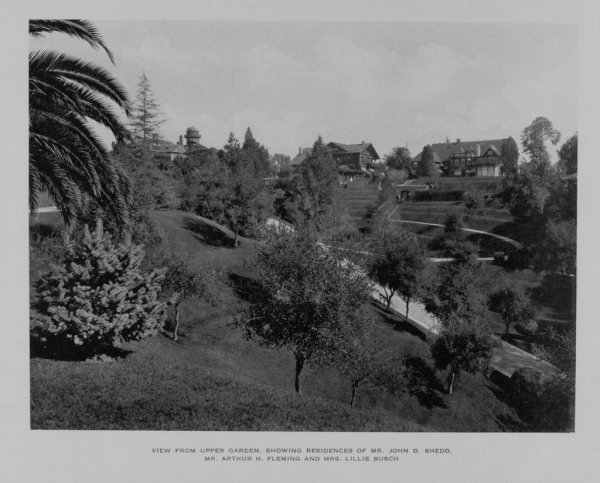



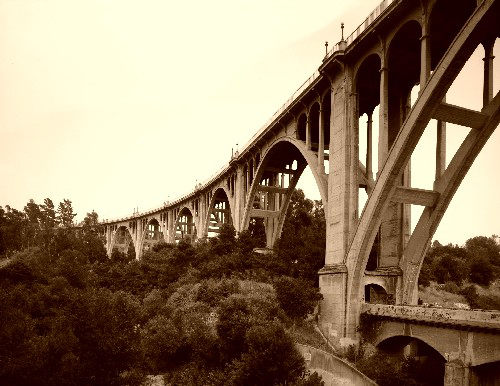

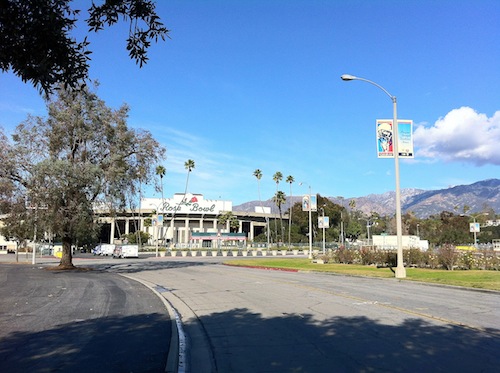



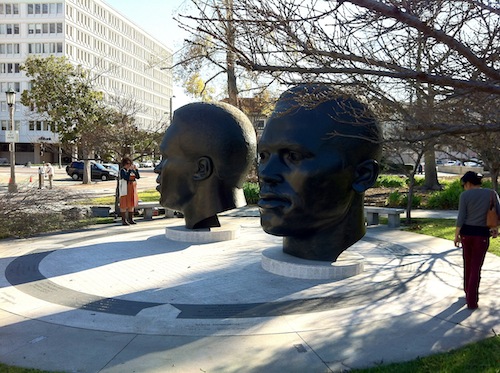

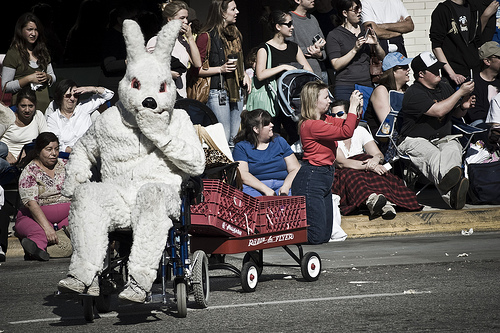
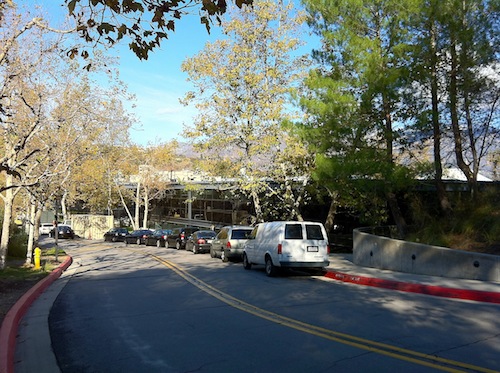
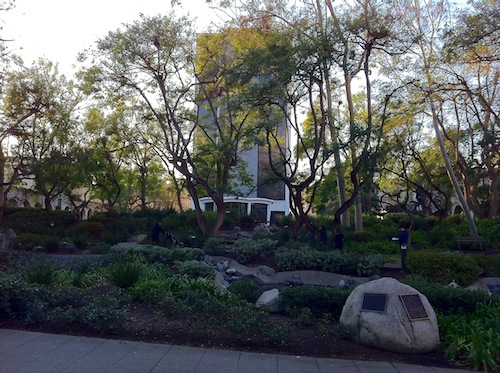
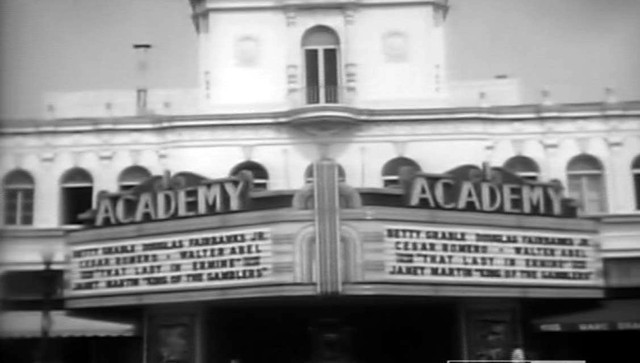


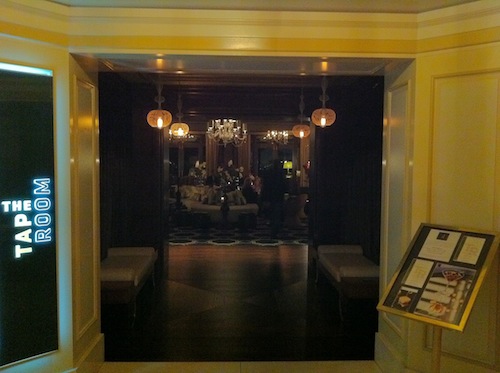


60 thoughts on “California Fool’s Gold — Exploring Pasadena, The Crown City of Roses”